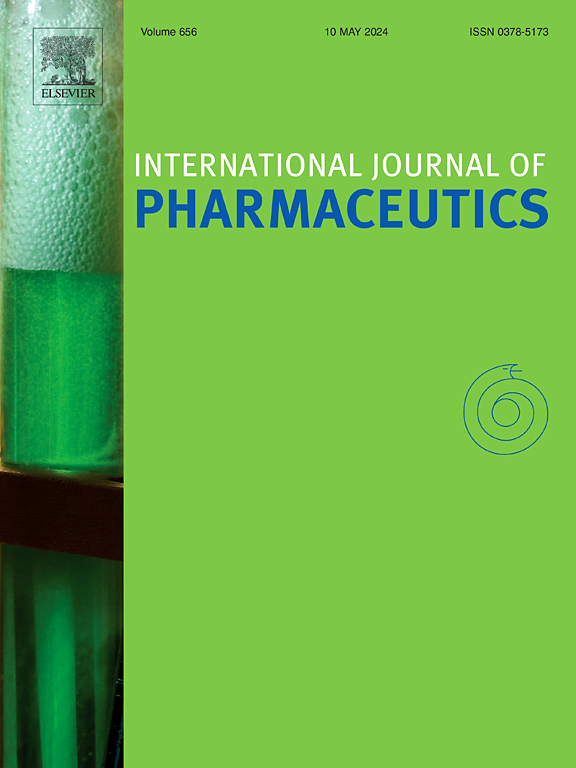自组装leuprolide-油酸纳米颗粒包封多西紫杉醇用于协同给药。
IF 5.2
2区 医学
Q1 PHARMACOLOGY & PHARMACY
引用次数: 0
摘要
本研究将肽药物LEU与OA偶联,形成自组装纳米颗粒(LON),合成了两亲性的LEU - oil - acid conjugate (LOC)。这可能会最大化脂肪酸和抗癌药物在前列腺癌中的协同作用。多西他赛(DTX)包封LON (LON)也被开发用于三协同给药。LON和LOND保持均匀的球形形态,粒径范围为130.6-159.1 ± 3.1 nm,具体取决于冷冻干燥或再分散过程。LON和DTX包封均未改变LEU圆二色性(CD)的结构行为。在贮存过程中,纳米颗粒的粒径和多分散性指数(PDI)也保持稳定。在Franz扩散池中,LOND表现出优异的膜透性。此外,使用基于Intralipid®的吸收测定法观察到高淋巴吸收。LON或LOND的LEU和DTX受控释放7 d。值得注意的是,酯酶(5 U/mL)显著降低了LEU、DTX和LOC的释放。由于LON中的LOC被酶切,LEU的释放率较高。相比之下,由于失去了纳米颗粒结构,从LOND中获得了更高的DTX释放率,但较低的LEU。在细胞毒性实验中,LOND对PC3人前列腺癌细胞的细胞毒性明显高于LEU或DTX,而对正常人包皮成纤维细胞(HFF-1)细胞没有明显的细胞毒性。此外,共聚焦显微镜证实了PC-3和RAW 264.7巨噬细胞对纳米颗粒的细胞摄取。基于这些发现,LOND同时释放LEU、DTX和脂肪酸(如OA),为三重协同治疗前列腺癌提供了一个有前景的给药平台。本文章由计算机程序翻译,如有差异,请以英文原文为准。

Self-assembled leuprolide-oleic acid nanoparticles encapsulating docetaxel for synergistic drug delivery
In the present study, an amphiphilic leuprolide acetate (LEU)-oleic acid (OA) conjugate (LOC) was synthesized by conjugating the peptide drug LEU with OA to form self-assembled nanoparticles (LON). This may maximize the synergistic effectiveness of fatty acids and anticancer drugs in prostate cancer. Docetaxel (DTX)-encapsulating LON (LOND) have also been developed for triple-synergistic drug delivery. LON and LOND retained a uniformly spherical morphology and had particle sizes ranging 130.6–159.1 ± 3.1 nm, depending on the freeze drying or redispersion process. Neither LON nor encapsulation of DTX into LON altered the structural behavior of LEU circular dichroism (CD). The nanoparticles were also stable in terms of particle size and polydispersity index (PDI) during storage. LOND exhibited excellent membrane permeability using a Franz diffusion cell. In addition, high lymphatic uptake was observed using an Intralipid®-based absorption assay. LEU and DTX from LON or LOND were released in a controlled manner for 7 d. Notably, the esterase (5 U/mL) significantly decreased the release of LEU, DTX, and LOC. As LOC from LON was enzymatically cleaved, a higher release rate of LEU was achieved. In contrast, a higher release rate of DTX but a lower LEU from LOND was achieved by losing the nanoparticle structure. In a cytotoxicity assay, LOND exhibited significantly higher cytotoxicity against PC3 human prostate cancer cells than LEU or DTX alone, whereas no significant cytotoxicity was observed in normal human foreskin fibroblast (HFF-1) cells. Furthermore, confocal microscopy confirmed the cellular uptake of the nanoparticles in both PC-3 and RAW 264.7 macrophage cells. Based on these findings, LOND, simultaneously releasing LEU, DTX, and fatty acids (such as OA), provides a promising drug delivery platform for triple synergy in the treatment of prostate cancer.
求助全文
通过发布文献求助,成功后即可免费获取论文全文。
去求助
来源期刊
CiteScore
10.70
自引率
8.60%
发文量
951
审稿时长
72 days
期刊介绍:
The International Journal of Pharmaceutics is the third most cited journal in the "Pharmacy & Pharmacology" category out of 366 journals, being the true home for pharmaceutical scientists concerned with the physical, chemical and biological properties of devices and delivery systems for drugs, vaccines and biologicals, including their design, manufacture and evaluation. This includes evaluation of the properties of drugs, excipients such as surfactants and polymers and novel materials. The journal has special sections on pharmaceutical nanotechnology and personalized medicines, and publishes research papers, reviews, commentaries and letters to the editor as well as special issues.

 求助内容:
求助内容: 应助结果提醒方式:
应助结果提醒方式:


